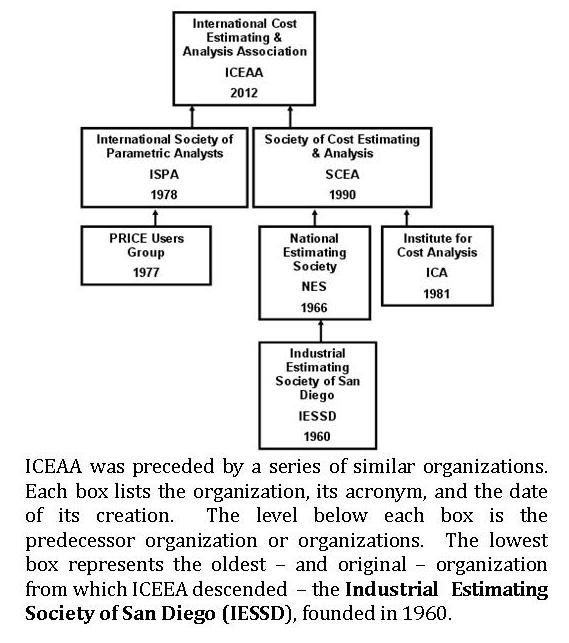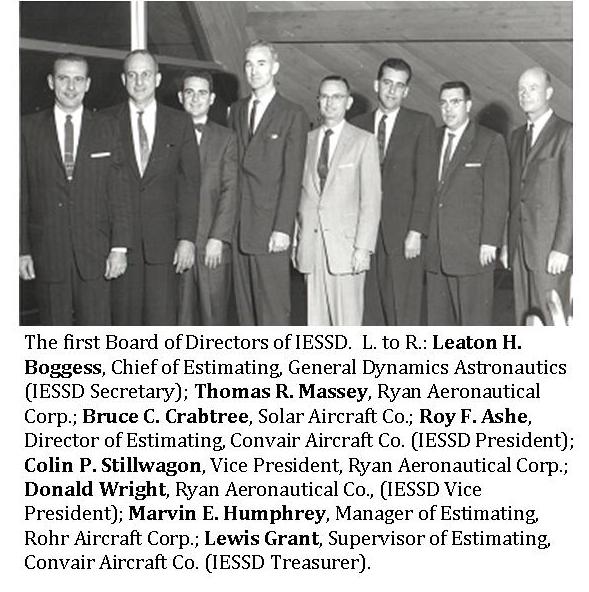ICEAA was formed by the merger of the International Society of Parametric Analysts (ISPA) and the Society of Cost Estimating and Analysis (SCEA) in November 2012.
ISPA was created in 1979 when more than 300 analysts and managers assembled in Washington DC to promote parametric methods in cost analysis. Bryant Barnes was elected the first ISPA President with Hank Apgar as Vice-President.
SCEA was formed following the merger of the National Estimating Society (NES) and the Institute of Cost Analysis (ICA) in 1990. NES was predominantly an industry association and ICA was predominantly a government association. The combination of the two was a logical merger opportunity. Ray Crum of (then) TRW was chosen as SCEA’s first President, and Neil Albert of MCR was selected to be Vice-President. Lee Baseman was appointed to be the first Executive Director of SCEA.
ISPA and SCEA have cooperated for many years for the benefit of their respective members. In 1998, the first joint ISPA-SCEA annual Conference and Training Program was held, providing a forum for members to collaborate on training and discuss issues paramount to both groups. This extremely successful cooperative effort continued for the next 13 years. In 2005, a Jointness Committee was formed, led by Neil Albert and Hank Apgar and comprised of appointed members from each society. The committee’s purpose was to explore opportunities where the two societies could benefit from working together, while testing the possibility of a future merger. A key success occurred in 2007 when the Societies reached an agreement for the SCEA national office staff to pick up administration of ISPA business activities.
The integrated business operation created greater efficiency and savings for both societies, as well as a much better coordination of activities generally between the two Boards of Directors and their staffs. In 2008, the Jointness Committee celebrated another success with the formation of a joint journal, combining SCEA’s Journal of Cost Analysis and Management and ISPA’s Journal of Parametrics to form the Journal of Cost Analysis and Parametrics.
In June 2011, after years working together through the Jointness Committee and continuous collaboration, the Boards of ISPA and the SCEA decided to merge. In the subsequent year, a committee made up of ISPA and SCEA Board members drafted the legal and operational details related to the merger, and presented those to the each Board for their approval.
The merger was approved by both Boards in June 2012, and was legally approved in November 2012, forming the International Cost Estimating and Analysis Association (ICEAA). Today ICEAA sets the standard for promoting cost estimating and analysis within Government and industry, for providing training in the Body of Knowledge, for professional certification, and for propagation of ethics and standards of conduct throughout the cost estimating and analysis profession.

The concept of a professional association for systems cost estimators was born in the mind of Mr. Roy F. Ashe, who was Director of Estimating for Convair Aircraft, a division of General Dynamics Corp. in San Diego, California. It was he who first suggested organizing an association for systems estimators, and promoted that notion among his peers in the local San Diego industry. There already existed similar professional associations for other sub-sets of costing, such as civil engineering and construction, but Roy Ashe was involved in the development and production of military and commercial aircraft. A dominant industry in the San Diego area at that time, Ashe felt there was a significant population of estimating professionals in the field that could benefit from such an organization.
He began by writing letters to several professional associates at such companies as General Dynamics, Ryan Aircraft, Rohr Aircraft, and Solar Corp., an aircraft parts fabrication house, suggesting that a professional association focused on aircraft industry costing be organized. Through the fall of 1959, this group met periodically to discuss how to proceed, and then to create the necessary documents that formed the basis of an association. On October 22, 1959, they completed a set of Bylaws and Articles of Incorporation, which were submitted to the State of California for approval. The charter for the new entity – which was named the Industrial Estimating Society of San Diego – was issued. The first set of officers identified in the charter were:
President – Roy F. Ashe, Convair Aircraft
Vice President – Donald Wright, Ryan Aeronautical Company
Secretary – Leaton H. Boggess, General Dynamics Astronautics
Treasurer – Lewis Grant, Convair Aircraft

The next step was finding the membership. By word of mouth and corporate communications, the estimating staff of every aircraft-related company and contractor in the San Diego area was invited to a dinner at the Catamaran Hotel on Mission Bay, January 5th, 1960. While the founding group was uncertain what the response would be, any fears proved groundless as over 200 professional estimators turned out, and the IESSD became a reality. Roy Ashe addressed the assembled costers, and explained what he and his founding group were looking for.
“The thought is to bring together the best talent available on the estimating subject in order to promote and exchange ideas. Each of you will have the opportunity to review and evaluate practices and procedures used by other companies to increase your personal skills, thereby increasing your value to your company and to the industrial community as a whole.”
Roy Ashe wanted the estimators from all of the companies to share their knowledge and processes with each other and thereby improve the abilities and products of all. He saw the IESSD as a vehicle for that interchange and professional growth of all its members, and as a force for expanding the knowledge of the profession.
Besides the interchange of ideas and techniques, Ashe offered a set of five objectives envisioned for the new organization:
- To cultivate an understanding of the estimating function as an aid to, and as a part of, effective management.
- To provide through interchange of information the means for increasing the competence of all those who are responsible for the preparation and presentation of cost and price estimates.
- To collect, develop, and disseminate information relative to estimating techniques, procedures, and criteria that is compatible with current technological and economic conditions.
- To provide through the exchange of information for the continuing improvement of the procedures and techniques utilized in contract negotiations.
- To make available to educational institutions procedural information collected from the membership and form research activities.
As a result of the founding dinner, 126 estimators signed up for membership. The first member, beyond the founding Board, was Mr. E. N. Gray, an estimator at Rohr Aircraft. For the next five years, the IESSD served the San Diego estimating community. In 1965, growth and expansion of costing professionalism beyond the aircraft industry led to the founding of a national organization with much broader goals, and thus a necessary change in the name – to the “National Estimating Society”. The first NES President was Marvin Humphrey, of Rohr Aircraft.
